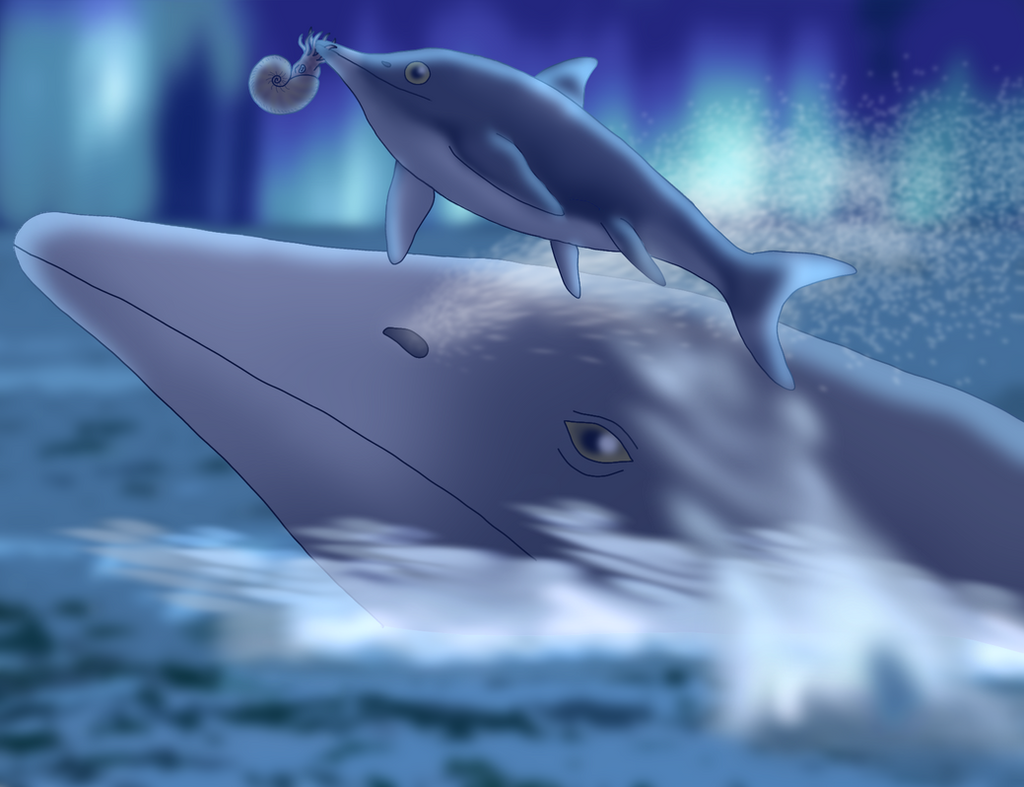HOME | DD
 Olmagon — Triassic Arctic Ocean
Olmagon — Triassic Arctic Ocean

#ammonite #animal #aquatic #arctic #arcticocean #aurora #auroraborealis #cephalopod #christmas #digitaldrawing #digitalpainting #dinosaur #ichthyosaur #marinelife #marinereptile #mesozoic #night #northernlights #ocean #paleoart #paleontology #triassic #paleoillustration #shastasauridae #shonisaurus #shastasaurus #christmas2021 #auroroborealia #orientosirenites #sirenites
Published: 2021-12-20 00:34:58 +0000 UTC; Views: 21285; Favourites: 216; Downloads: 6
Redirect to original
Description
210 million years ago during a winter of the late Triassic period in an area of ocean within the Arctic Circle where the New Siberian Islands of Russia are now, a small basal ichthyosaur of the species Auroroborealia incognita leaps out of the water. In the jaws of the 1.5-meter long marine reptile is its prey, an ammonite known as Orientosirenites bytschkovi that has been grabbed by the tentacle which can now only hope its shell will save its life. However there are also much larger animals in these waters, and Auroroborealia isn't even the largest local ichthyosaur. At the same time the small ichthyosaur jumps with its prey, a much larger shastasaurid ichthyosaur growing over 10 meters long breaches its head above the surface right next to its smaller relative to get another breath of air. As reptiles, ichthyosaurs must surface to breathe from time to time, and as the shastasaur exhales it also spouts out a lot of water like a whale does, all while the northern lights shimmer in the night sky above.So since Christmas is coming in a few days it felt right to draw some winter-ish stuff and a newly described extinct animal felt like a good fit. Described just a week ago on December 13 2021, Auroroborealia incognita is an early ichthyosaur (an extinct order of dolphin-like marine reptiles) that was found in Triassic-aged rocks in the New Siberian Islands of Russia, in the Arctic Ocean off the northeast Asian coast. Kinda obviously, this marine reptile is named after the Aurora borealis, the northern lights that can be seen in the night sky in and around the Arctic circle during winter. Unfortunately the remains of the animal are quite fragmentary so its exact placement within the ichthyosaur family tree is uncertain, though it has been compared to Hudsonelpidia from Triassic Canada. It is believed that Auroroborealia was only 1 to 1.5 meters long, being quite small for ichthyosaurs. While it is true that global temperatures were higher in the Mesozoic than they are now, the New Siberian Islands would have already been well within the Arctic Circle during the Triassic period and during the winter the temperature may have dropped barely below 0°C (according to this www.researchgate.net/figure/Ja… ), so the ichthyosaur may well have had a thick layer of fat for insulation. And given the high latitude, the Aurora borealis could probably have been seen there during the winter already.
Auroroborealia wasn't the only ichthyosaur from its habitat though, and the paper describing it also mentions that fossil remains of at least two larger ichthyosaurs were found at the same site. However, these are all too fragmentary to ne described officially as new species or assigned to pre-existing genera, with Auroroborealia being the only one barely complete enough for that. The largest of these remains are believed to be from some undetermined species of huge ichthyosaur in the Shastasauridae family, with the few fragmentary remains suggesting it was bigger than Shastasaurus pacificus but smaller than Shonisaurus (so somewhere between 10 and 14 meters long). The shastasaurids were the largest of ichthyosaurs, with some species rumored to have even been comparable in size to a blue whale (though this has been debated) and the majority of species were specialist squid-eaters (though one Guizhouichthyosaurus specimen was found with a 4-meter marine reptile called Xinpusaurus as its stomach contents), believed to have engaged in suction feeding.
First Orientosirenites and New Siberian shastasaurid on DA too!
Related content
Comments: 26

👍: 0 ⏩: 1

👍: 0 ⏩: 1

👍: 0 ⏩: 1

👍: 0 ⏩: 1

👍: 1 ⏩: 1

👍: 0 ⏩: 0

👍: 0 ⏩: 1

👍: 0 ⏩: 0

👍: 0 ⏩: 1

👍: 0 ⏩: 0

👍: 1 ⏩: 1

👍: 1 ⏩: 1

👍: 0 ⏩: 0

👍: 0 ⏩: 1

👍: 0 ⏩: 1

👍: 0 ⏩: 0

👍: 0 ⏩: 1

👍: 0 ⏩: 2

👍: 0 ⏩: 0

👍: 0 ⏩: 0

👍: 0 ⏩: 1

























